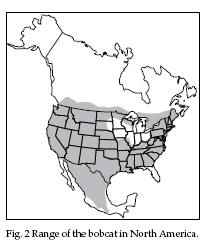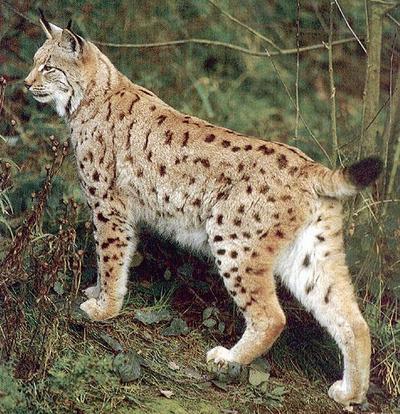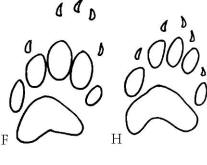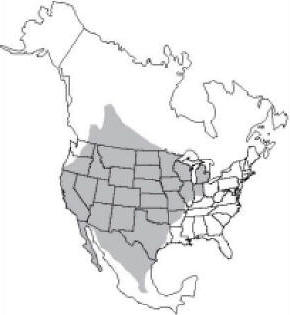Identification
The cat has been the most resistant to change of all the animals that humans have domesticated. All members of the cat family, wild or domesticated, have a broad, stubby skull, similar facial characteristics, lithe, stealthy movements, retractable claws (except the cheetah), and nocturnal habits.
Feral cats (Fig. 1) are house cats living in the wild. They are small in stature, weighing from 3 to 8 pounds (1.4 to 3.6 kg), standing 8 to 12 inches (20 to 30.5 cm) high at the shoulder, and 14 to 24 inches (35.5 to 61 cm) long. The tail adds another 8 to 12 inches (20 to 30.5 cm) to their length. Colors range from black to white to orange, and an amazing variety of combinations in between. Other hair characteristics also vary greatly.
Range
Cats are found in commensal relationships wherever people are found. In some urban and suburban areas, cat populations equal human populations. In many suburban and eastern rural areas, feral house cats are the most abundant predators.
Habitat
Feral cats prefer areas in and around human habitation. They use abandoned buildings, barns, haystacks, post piles, junked cars, brush piles, weedy areas, culverts, and other places that provide cover and protection.
Food Habits
Feral cats are opportunistic predators and scavengers that feed on rodents, rabbits, shrews, moles, birds, insects, reptiles, amphibians, fish, carrion, garbage, vegetation, and leftover pet food.
General Biology, Reproduction, and Behavior
Feral cats produce 2 to 10 kittens during any month of the year. An adult female may produce 3 litters per year where food and habitat are sufficient. Cats may be active during the day but typically are more active during twilight or night. House cats live up to 27 years. Feral cats, however, probably average only 3 to 5 years. They are territorial and move within a home range of roughly 1.5 square miles (4 km2). After several generations, feral cats can be considered to be totally wild in habits and temperament.
Damage
Feral cats feed extensively on songbirds, game birds, mice and other rodents, rabbits, and other wildlife. In doing so, they lower the carrying capacity of an area for native predators such as foxes, raccoons, coyotes, bobcats, weasels, and other animals that compete for the same food base.
Where documented, their impact on wildlife populations in suburban and rural areas—directly by predation and indirectly by competition for food— appears enormous. A study under way at the University of Wisconsin (Coleman and Temple 1989) may provide some indication of the extent of their impact in the United States as compared to that in the United Kingdom, where Britain’s five million house cats may take an annual toll of some 70 million animals and birds (Churcher and Lawton 1987). Feral cats occasionally kill poultry and injure house cats.
Feral cats serve as a reservoir for human and wildlife diseases, including cat scratch fever, distemper, histoplasmosis, leptospirosis, mumps, plague, rabies, ringworm, salmonellosis, toxoplasmosis, tularemia, and various endo- and ectoparasites.
Legal Status
Cats are considered personal property if ownership can be established through collars, registration tags, tattoos, brands, or legal description and proof of ownership. Cats without identification are considered feral and are rarely protected under state law. They become the property of the landowner upon whose land they exist. Municipal and county animal control agencies, humane animal shelters, and various other public and private “pet†management agencies exist because of feral or unwanted house cats and dogs. These agencies destroy millions of stray cats annually.
State, county, and municipal laws related to cats vary. Before lethal control is undertaken, consult local laws. If live capture is desired, consult the local animal control agency for instructions on disposal of cats.
Damage Prevention and Control Methods
Exclusion
Exclusion by fencing, repairing windows, doors, and plugging holes in buildings is often a practical way of eliminating cat predation and nuisance. Provide overhead fencing to keep cats out of bird or poultry pens. Wire mesh with openings smaller than 2.5 inches (6.4 cm) should offer adequate protection.
Cultural Methods
Cat numbers can be reduced by eliminating their habitat. Old buildings should be sealed and holes under foundations plugged. Remove brush and piles of debris, bale piles, old machinery, and junked cars. Mow vegetation in the vicinity of buildings. Elimination of small rodents and other foodstuffs will reduce feral cat numbers.
Repellents
The Environmental Protection Agency (EPA) has registered the following chemicals individually and in combination for repelling house cats: anise oil, methyl nonyl ketone, Ro-pel, and Thymol. There is little objective evidence, however, of these chemicals’ effectiveness. Some labels carry the instructions that when used indoors, “disciplinary action†must reinforce the repellent effect. Some repellents carry warnings about fabric damage and possible phytotoxicity. When used outdoors, repellents must be reapplied frequently. Outdoor repellents can be used around flower boxes, furniture, bushes, trees, and other areas where cats are not welcomed. Pet stores and garden supply shops carry, or can order, such repellents. The repellents are often irritating and repulsive to humans as well as cats.
Frightening
Dogs that show aggression to cats provide an effective deterrent when placed in fenced yards and buildings where cats are not welcome.
Toxicants
No toxicants are registered for control of feral cats.
Fumigants
No fumigants are registered for control of feral house cats. Live-trapped cats or cats in holes or culverts can be euthanized with carbon dioxide gas or pulverized dry ice (carbon dioxide) at roughly 1/2 pound per cubic yard (0.3 kg/m3) of space.
Trapping



